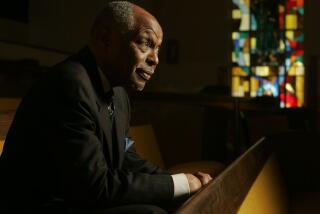Before Charleston attack, a long history of violence against black churches
For 90 years, Mt. Zion African Methodist Episcopal Church stood as a place of worship in Greeleyville, S.C.
On June 20, 1995, it was burned to the ground.
Two young white men with suspected ties to the Ku Klux Klan were arrested in connection with the fire, according to documents from House Judiciary Committee hearings held in 1996.
“To see the church burned was sad to me, but to learn that the church was burned by hideous acts of others crushed my heart,” the Rev. Terrance G. Mackey, pastor of Mt. Zion, said during the hearings.
His words then echo the emotions after last week’s attack on the historic Emanuel AME Church in Charleston, S.C.: “To know that in 1995 people still have that much hate in their hearts for others, I said to myself: Are we going forward or are we going backward in this country?”
Mackey’s question to Congress had no clear answer.
Even then-President Clinton’s response almost a year later sounds familiar today: “We need to come together as one America to rebuild our churches, restore hope and show the forces of hatred that they cannot win,” he said before heading to Greeleyville, where Mt. Zion was being rebuilt.
Indeed, 20 years ago, a string of churches was burned, mostly in Southern states — a statistic cited by Republican Rep. Henry J. Hyde of Illinois, then chairman of the Judiciary Committee.
“This year alone there have been 21 church fires involving African American churches,” he said at the time, noting there was “considerable evidence that some of these church fires were connected and that some were racially motivated incidents.”
One black congressman from Alabama likened the church attacks to the biblical plague. “Over the past three years, the incidents of black church burnings have nearly quadrupled,” Rep. Earl F. Hilliard, a Democrat, told the House committee. “The small town of Boligee in my district was devastated by church fires. In two separate attacks, arsonists torched four black churches before escaping unseen into the night.”
Four African American churches were burned in west Tennessee in 1995, including two on the same day: Macedonia Missionary Baptist Church in Crockett County and Johnson Grove Missionary Baptist Church in Madison County on Jan. 13.
Some fires included racist messages. On Jan. 8, 1996, the sanctuary of the Inner City Church in Knoxville, Tenn., was destroyed. Racial slurs directed at African Americans were spray-painted on the doors and walls of the building, according to congressional documents. The church had more than 500 members of various races.
The task force investigating the incident consisted of 70 federal and local officials.
However, according to a report from the Justice Department’s Office of the Inspector General, controversy erupted when the NAACP learned of possible connections between federal and local law enforcement officials investigating the church fires and the “Good O’ Boy Roundups.”
The Roundups were racially fueled, whites-only gatherings attended by federal and local law enforcement, including members of the Bureau of Alcohol, Tobacco and Firearms, as the agency was then known, according to the report.
“Several African Americans in Tennessee expressed distrust of the Knoxville Police Department and ATF because of the widespread belief that members of both agencies had participated in such a racially offensive event,” the inspector general’s report stated. “Our local NAACP officials wondered whether ATF agents involved in such despicable and overtly racist conduct as the ‘Good O’ Boy Roundups’ possess the sensitivity to vigorously pursue justice in what many believe are racially motivated hate crimes.”
In the violence in Charleston last week, nine African Americans were fatally shot in what is being investigated as a hate crime. A white 21-year-old suspect, Dylann Roof, has been arrested and charged with murder.
“We welcomed you Wednesday night in our Bible study with open arms,” Felecia Sanders said before a video feed of Roof shown in the courtroom last week during his bond hearing. “You have killed some of the most beautifulest people that I know. Every fiber in my body hurts … and I’ll never be the same.”
Sanders survived the shootings, but her son, Tywanza, 26, was killed.
The attack, in which each victim was shot multiple times, is among the most horrific entries on a list that goes back decades and includes the 1963 bombing of the 16th Street Baptist Church in Birmingham, Ala.
Ku Klux Klan members planted the Birmingham bomb, which killed four African American girls. The Rev. Martin Luther King Jr. called it “one of the most vicious and tragic crimes ever perpetrated against humanity.”
In Charleston on Friday, NAACP President Cornell William Brooks called the Emanuel AME shootings “an act of racial terrorism.”
“This crime may have occurred in moments. But it came into being over some time,” Brooks said Sunday on CBS’ “Face the Nation.” “This young man was indoctrinated, radicalized, if you will, with an ideology of white nationalism or racism. And so the point being here is we’ve got to look at not only this individual act of brutality. We also have to look at the atmosphere from which it emerged. And we have to address that.”
Emanuel is the oldest AME church in the South, tracing its roots as far back as 1791, according to the National Parks Service. Emanuel also was once burned to the ground — in 1822, for its connection to an aborted slave revolt.
In the Mt. Zion case, the two suspects were former Ku Klux Klansmen who pleaded guilty to federal charges of civil rights violations in the burnings of two predominantly black churches, one of them Mt. Zion. In 1998, both saw their sentences reduced after providing information in other cases, including a burglary and a check fraud scheme. Gary Cox had his 19-year sentence reduced to 14 years and Timothy Welch’s sentence was cut from 18 years to 12 years.
Follow Ryan Parker on Twitter, Facebook and Instagram
More to Read
Sign up for Essential California
The most important California stories and recommendations in your inbox every morning.
You may occasionally receive promotional content from the Los Angeles Times.











